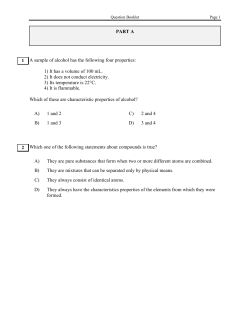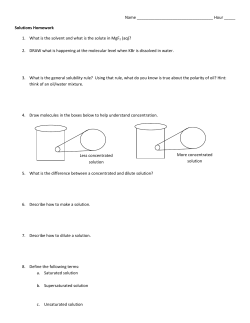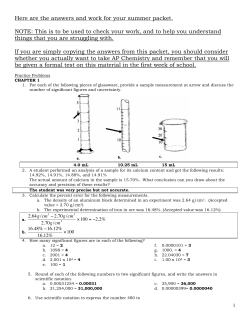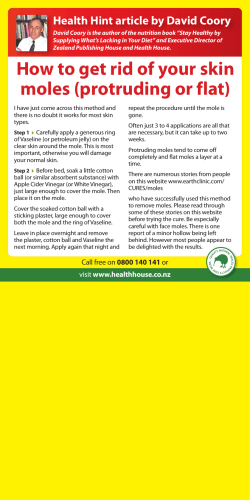
Sample Test Questions for the Physical Setting/Chemistry Regents Examination Part A
Sample Test Questions for the Physical Setting/Chemistry Regents Examination Part A Answer all questions in this part. Directions (1–35): For each statement or question, write on the separate answer sheet the number of the word or expression that, of those given, best completes the statement or answers the question. Some questions may require the use of the Reference Tables for Physical Setting/Chemistry. 1 Compared to an atom of hydrogen in the ground state, an atom of hydrogen in the excited state has (1) (2) (3) (4) absorbed energy, only released energy, only neither released nor absorbed energy both released and absorbed energy 2 What is the total number of electrons in the outermost shell of a phosphorus atom in the ground state? (1) (2) (3) (4) 1 2 3 5 3 Based on Reference Table S, which of the following atoms requires the least energy for the removal of the most loosely bound electron? (1) (2) (3) (4) 4 Sn Sr Be Br What is the mass number of (1) (2) (3) (4) 19 9 F? 9 10 19 28 5 All atoms of a given element must contain the same number of (1) (2) (3) (4) protons neutrons electrons plus neutrons protons plus neutrons 3 6 Which element is a brittle, nonconducting solid at 25°C? (1) (2) (3) (4) Br S Al Bi 7 An atom of helium-4 differs from an atom of lithium-7 in that the atom of helium-4 has (1) (2) (3) (4) one more proton one more neutron two less protons two less neutrons 8 Antimony is classified as a (1) (2) (3) (4) metal nonmetal metalloid noble gas 9 Given the reaction: 2C H +7O 2 6 2 4 CO + 6 H O 2 2 What is the ratio of moles of CO produced to moles of C H consumed? 2 2 6 (1) 1 to 1 (2) 2 to 1 (3) 3 to 2 (4) 7 to 2 10 Which equation shows conservation of charge? 2+ Fe + e 2+ (2) Fe + 2e Fe 2+ (3) Fe Fe + 2e 3+ (4) Fe + 2e Fe (1) Fe 11 What is the formula of nitrogen (II) oxide? (1) NO (2) NO 2 (3) N O 2 (4) N O 2 4 4 12 Which formula represents an ionic compound? (1) H O 2 (2) KCl (3) NH 3 (4) CH 4 13 An oxide ion (O (1) (2) (3) (4) 2– ) formed from an oxygen-18 atom contains exactly 8 protons, 8 neutrons, 10 electrons 8 protons, 10 neutrons, 8 electrons 8 protons, 10 neutrons, 10 electrons 10 protons, 8 neutrons, 8 electrons 14 Which bond is least polar? (1) (2) (3) (4) As–Cl Bi–Cl P–Cl N–Cl 15 Which pair of characteristics describes the molecule illustrated below? Ø Ñ Ø (1) (2) (3) (4) symmetrical and polar symmetrical and nonpolar asymmetrical and polar asymmetrical and nonpolar 16 A sample of unknown composition was tested in a laboratory. The sample could not be decomposed by physical or chemical means. On the basis of these results, the laboratory reported that the unknown sample was most likely (1) (2) (3) (4) a compound an element a mixture a solution 17 Which intermolecular force of attraction accounts for the relatively high boiling point of water? (1) (2) (3) (4) hydrogen bonding covalent bonding metallic bonding ionic bonding 5 18 Based on Reference Table H, which substance has the weakest intermolecular forces? (1) (2) (3) (4) ethanoic acid ethanol propanone water 19 At 1 atmosphere and 298 K, 1 mole of H O ( ) molecules and 1 mole of C H OH ( ) molecules both have the same 2 2 5 (1) vapor pressure (2) average kinetic energy (3) mass (4) density 20 Given the reaction at equilibrium: C2(g) + D2(g) ÁÁ 2 CD(g) + energy Which change will cause the equilibrium to shift? (1) (2) (3) (4) increase in pressure increase in volume addition of heat addition of a catalyst 21 Given the equilibrium at 101.3 kPa: H2O (s) ÁÁ H2O( ) At what temperature does this equilibrium occur? (1) (2) (3) (4) 100 K 273 K 298 K 373 K 6 22 Given the diagram below that shows carbon dioxide in an equilibrium system at a temperature of 298 K and a pressure of 1 atm: °·-¬±² ø³±ª¿¾´»÷ ÝÑîø¯÷ ÝÑ îø¹÷ ½§´·²¼»® ÝÑîø¿¯÷ ÝÑ îø¿¯÷ Which changes must increase the solubility of the carbon dioxide? (1) (2) (3) (4) increase pressure and decrease temperature increase pressure and increase temperature decrease pressure and decrease temperature decrease pressure and increase temperature 23 Which formula represents a molecule of a saturated hydrocarbon? (1) C H 2 2 (2) C H 4 10 (3) C H 5 8 (4) C H 6 6 24 Molecules of 2-methyl butane and 2,2-dimethyl propane have different (1) (2) (3) (4) structural formulas molecular formulas numbers of carbon atoms numbers of covalent bonds 25 The molecule below belongs to which class of compounds? Á Á Á Á Ñ Ø Ø Á ØÑ Ý Á Ý Á Ò Á Ø ØÁ ÝÁ Ø Á Á Ø (1) (2) (3) (4) alcohol ester aldehyde amino acid 7 26 The transfer of which particle is required for a redox reaction to occur? (1) (2) (3) (4) electron ion neutron proton 27 What is the oxidation number of chromium in K Cr O ? 2 2 7 (1) +6 (2) +2 (3) +7 (4) +12 28 Given the reaction: Mg + CuSO 4 MgSO + Cu 4 Which equation represents the oxidation that takes place? 2+ – (1) Mg + 2e Mg 2+ – (2) Mg Mg + 2e 2+ – (3) Cu + 2e Cu 2+ – (4) Cu Cu + 2e 29 Which substance is an Arrhenius acid? (1) NH 3 (2) KOH (3) HC H O 2 3 2 (4) CH OH 3 30 Which of the following pH values indicates the highest concentration of hydronium ions in a solution? (1) (2) (3) (4) pH = 1 pH = 2 pH = 3 pH = 4 31 Which substance yields hydroxide ion as the only negative ion in aqueous solution? (1) Mg(OH) 2 (2) C H (OH) 2 4 2 (3) MgCl 2 (4) CH Cl 3 8 32 Which type of radiation is identical in mass and charge to a helium nucleus? (1) (2) (3) (4) alpha beta positron proton 33 Which isotope is radioactive? (1) (2) (3) (4) C–12 Ne–20 Tc–99 Pb–206 34 Which equation represents nuclear fusion? (1) (2) (3) (4) 14 C 14 N + -10e 6 7 4 27 30 Al + 2 He 15 P + 10 n 13 235 1 139 U + 0n Ba + 94 Kr 92 56 36 2 1 H + 31H 42He + 0n 1 + 3 10 n Note that question 35 has only three choices. 35 In a gaseous system at equilibrium with its surroundings, as molecules of A(g) collide with molecules of B(g) without reacting, the total energy of the gaseous system (1) decreases (2) increases (3) remains the same 9 Part B Answer all questions in this part. Directions (36–50): For each statement or question, write on the separate answer sheet the number of the word or expression that, of those given, best completes the statement or answers the question. Some questions may require the use of the Reference Tables for Physical Setting/Chemistry. 36 The temperature of a 2.0-liter sample of helium gas at STP is increased to 27°C and the pressure is decreased to 80. kPa What is the new volume of the helium sample? (1) (2) (3) (4) 1.4 L 2.0 L 2.8 L 4.0 L 37 Given the reaction: 2C H +7O 2 6 2 4 CO + 6 H O 2 2 What is the total number of moles of CO produced by the complete combustion of 5.0 moles of C H ? 2 2 6 (1) 1.0 mole (2) 2.0 moles (3) 5.0 moles (4) 10. moles 38 Approximately what fraction of an original Co–60 sample remains after 21 years? (1) 1 2 (2) 1 4 (3) 1 8 (4) 1 16 10 Ю»--«®» Ю»--«®» 39 Which graph best shows the relationship between the pressure of a gas and its average kinetic energy at constant volume? ߪ»®¿¹» ÕòÛò ߪ»®¿¹» ÕòÛò øí÷ Ю»--«®» Ю»--«®» øï÷ ߪ»®¿¹» ÕòÛò ߪ»®¿¹» ÕòÛò øî÷ øì÷ 40 Which two solutions, when mixed together, will undergo a double replacement reaction and form a white, solid substance? (1) NaCl(aq) and LiNO3(aq) (2) KCl(aq) and AgNO3(aq) (3) KCl(aq) and LiCl(aq) (4) NaNO3(aq) and AgNO3(aq) 41 An unknown substance, liquid X, is tested in the laboratory. The chemical and physical test results are listed below. • • • • • Nonconductor of electricity Insoluble in water Soluble in hexane Low melting point as a solid Combustion produces only CO2 and H2O Based on these results, a student should conclude that liquid X is (1) (2) (3) (4) ionic and organic ionic and inorganic covalent and organic covalent and inorganic 42 How many milliliters of 12.0 M HCl(aq) must be diluted with water to make exactly 500. mL of 3.00 M hydrochloric acid? (1) (2) (3) (4) 100. mL 125. mL 200. mL 250. mL 11 43 Based on Reference Table G, what is the maximum number of grams of KCl(s) that will dissolve in 200 grams of water at 50°C to produce a saturated solution? (1) (2) (3) (4) 38 g 42 g 58 g 84 g 44 What is the molarity of an HCl solution if 20. milliliters of this acid is needed to neutralize 10. milliliters of a 0.50 M NaOH solution? (1) (2) (3) (4) 1.0 M 0.75 M 0.50 M 0.25 M 45 During a laboratory experiment, a sample of aluminum is found to have a mass of 12.50 grams and a volume of 4.6 milliliters. What is the density of this sample, expressed to the correct number of significant figures? (1) (2) (3) (4) 2.717 g/mL 2.72 g/mL 3 g/mL 2.7 g/mL 46 Given the incomplete reaction: CH CH CH C–OH + x 3 2 2 O O CH CH CH C–OCH CH + H O 3 2 2 2 3 2 Which compound is represented by x? (1) CH CH OH 3 2 O (2) CH C–H 3 (3) CH OCH CH 3 2 3 O (4) CH CCH 3 3 12 47 A hydrate is a compound with water molecules incorporated into its crystal structure. In an experiment to find the percent by mass of water in a hydrated compound, the following data were recorded: Mass of crucible + hydrated crystals before heating 7.50 grams Mass of crucible 6.90 grams Mass of crucible + anhydrous crystals after heating 7.20 grams What is the percent by mass of water in the hydrate? (1) (2) (3) (4) 8.0 % 50. % 72. % 96. % ᬻ²¬·¿´ Û²»®¹§ ᬻ²¬·¿´ Û²»®¹§ 48 When a spark is applied to a mixture of hydrogen and oxygen, the gases react explosively. Which potential energy diagram best represents the reaction? øï÷ øí÷ ᬻ²¬·¿´ Û²»®¹§ λ¿½¬·±² ݱ±®¼·²¿¬» ᬻ²¬·¿´ Û²»®¹§ λ¿½¬·±² ݱ±®¼·²¿¬» λ¿½¬·±² ݱ±®¼·²¿¬» λ¿½¬·±² ݱ±®¼·²¿¬» øî÷ øì÷ 49 Which equation shows an increase in entropy? (1) CO2(g) (2) CO2( ) CO2(s) (3) CH3OH( ) (4) CH3OH(g) CO2(g) CH3OH(s) CH3OH( ) 50 The laboratory process of distillation does not involve (1) (2) (3) (4) changing a liquid to vapor changing a vapor to liquid liquids with different boiling points liquids with the same boiling points 13 Directions (51–55): Record your answers in the spaces provided in your answer booklet. Some questions may require the use of the Reference Tables for Physical Setting/Chemistry. 51 In a laboratory experiment, a student determined the mass of the product, NaCl(s), to be 1.84 grams. a Calculate the gram formula mass of NaCl(s). Round atomic masses from the Periodic Table to the nearest tenth. Show all work. [1] Indicate the correct answer, including an appropriate unit. [1] b Calculate the number of moles of NaCl(s) produced. Show all work. [1] Indicate the correct answer. [1] 52 Draw a correct Lewis electron-dot structure for each of the following in the boxes provided in your answer booklet. a An atom of hydrogen [1] b An atom of nitrogen [1] c A molecule of ammonia (NH3) [1] 53 Given the equation: CaCO (s) 3 CaO(s) + CO (g) 2 a Name the type of reaction this equation represents. [1] b Explain, in terms of particle behavior, why entropy is increasing during this reaction. [1] 54 Base your answers to question 54 on the information below: represents one molecule of nitrogen a In the space provided in your answer booklet, draw a particle model that shows at least six molecules of nitrogen gas. [1] b In the space provided in your answer booklet, draw a particle model that shows at least six molecules of liquid nitrogen. [1] c Describe, in terms of particle arrangement, the difference between nitrogen gas and liquid nitrogen. [1] d Good models should reflect the true nature of the concept being represented. What is a limitation of two-dimensional models? [1] 14 55 Given the graph below that represents the uniform cooling of a sample of lauric acid starting as a liquid above freezing point. Cooling Curve for Lauric Acid éð Ì»³°»®¿¬«®» ø Ý÷ êð ß ëð Ý Þ ìð Ü íð îð ïð ð ð ï î í ì ë ê é è ç ïð Ì·³» ø³·²÷ a Which line segment represents a phase change, only? [1] b What is the melting point of lauric acid? [1] c At which point do the particles of lauric acid have the highest average kinetic energy? [1] d Name the phase change that takes place during this 10-minute cooling time. [1] 15 Part C Answer all questions in this part. Directions (56–60): Record your answers in the spaces provided in your answer booklet. Some questions may require the use of the Reference Tables for Physical Setting/Chemistry. 56 Skiers, snowmobilers, and others involved in outdoor winter recreation use disposable heat packs. These heat packs are porous paper pouches containing sawdust, powdered carbon, sodium chloride, powdered iron, and Zeolite ™. During production, this mixture is moistened slightly with water and then sealed in an airtight plastic pack. The reaction starts when the pack is opened and the mixture is exposed to air. Given the unbalanced equation: Fe(s) + O2(g) Fe2O3(s) a In your answer booklet, balance the equation, using smallest whole number coefficients. [1] b If the word “energy” was added to the equation to correctly indicate the energy change in this heat pack reaction, would the word “energy” be placed on the “reactant side” or on the “product side” of the equation? [1] 57 Given the data table below showing the solubility of salt X: Temperature (oC) Mass of Solute per 100 g of H2O (g) 10 22 25 40. 30 48 60 107 70 135 a Which salt on Table G is most likely to be salt X? [1] b On the graph provided in your answer booklet, scale and label the y-axis including appropriate units. [1] c Plot the data from the data table. Surround each point with a small circle and draw a best-fit curve for the solubility of salt X. [1] d Using your graph, predict the solubility of salt X at 50o C. [1] e If the pressure on the salt solution was increased, what effect would this pressure change have on the solubility of the salt? [1] 16 58 In the early 1900s, evidence was discovered that atoms were not “hard spheres.” It was shown that atoms themselves had an internal structure. One experiment involved gold metal foil. a In your answer booklet, complete the simple model for an atom of gold-197 by placing the correct numbers in the two blanks. [1] b In the gold-foil experiment, alpha particles were directed toward the foil. Most of the alpha particles passed directly through the foil with no effect. This result did not agree with the “hard spheres model” for the atom. What conclusion about the internal structure of the atom did this evidence show? [1] c In the same experiment, some of the alpha particles returned toward the source. What does this evidence indicate about the charge of the atom’s nucleus? [1] 59 A student wishes to determine how the rate of reaction of magnesium strips with hydrochloric acid, HCl(aq), varies as a function of temperature of the HCl(aq). Give two additional factors, other than the temperature, that could affect the rate of reaction and must be held constant during the experiment. [2] Base your answers to question 60 on the article below and on your knowledge of chemistry. The Decaffeinating Tradition For coffee beans to be labeled “decaffeinated,” at least 97% of the caffeine must be removed. There are three primary methods for decaffeination: chemical extraction, the Swiss water process, and supercritical fluid extraction. Although all methods of decaffeinating coffee involve the use of “chemicals,” one process has been traditionally referred to as “chemical extraction,” probably because it uses organic solvents that are not typically part of our normal environment. The traditional method offers two slightly varied options using dichloromethane (CH2Cl2) or ethyl acetate (CH3COOC2H5) as solvents. With both solvents, the beans are first soaked in water to soften them and speed the decaffeinating process. The beans are then soaked in one of the two solvents, which dissolves the caffeine in the bean. Once the solvent has removed the caffeine, the coffee beans are treated with steam. This evaporates the organic solvent along with the caffeine. The process is identical for both solvents, but many coffee companies prefer to use ethyl acetate to decaffeinate their coffee. This allows them to label the beans “naturally decaffeinated,” because ethyl acetate occurs naturally in orange rinds and many other fruits. Although consumers may prefer this label, it is misleading. The ethyl acetate used is actually synthesized; it is not extracted from fruits because it would be too costly. Both of these commercial methods have a growing number of detractors, prompting many coffee companies to turn toward other methods. Opposition arises because the solvents used can never be completely removed from the coffee beans. The traces left behind, however, are below the amounts required for the “decaffeinated” label. Because of the recognized potential hazards associated with the use of dichloromethane and ethyl acetate, the United States Food and Drug Administration and the United States Department of Agriculture continue to investigate and evaluate any possible dangers that might be associated with the use of these chemicals. 60 a In the space provided in your answer booklet, draw the structural formula for ethyl acetate. (The correct IUPAC name is ethyl ethanoate.) [1] b To what class of organic compounds does ethyl acetate belong? [1] c In the space provided in your answer booklet, draw a correct structural formula for dichloromethane. [1] d To what class of organic compounds does dichloromethane belong? [1] e Which do you think is better, ethyl acetate or dichloromethane, as a decaffeinating agent for coffee? Explain your choice in terms of the information found in the article. [1] f Indicate whether you think the caffeine molecule is polar or nonpolar; then explain your answer in terms of the solubility of the caffeine molecule. [1] 17 Physical Setting/Chemistry Test Sampler Part B Answer Booklet 51 a b 52 a hydrogen b nitrogen c ammonia 18 53 a b 54 a b c d 55 a b c d 19 Physical Setting/Chemistry Test Sampler Part C Answer Booklet 56 a Fe(s) + O2(g) Fe2O3(s) b 57 a ͱ´«¾·´·¬§ ±º Í¿´¬ È b-c ð ïð îð íð ìð ëð êð éð Ì»³°»®¿¬«®» ø Ý÷ d e 20 èð çð ïðð 58 a éç °®±¬±²ÁÁÁ ²»«¬®±²- ÁÁÁ »´»½¬®±²- b c 59 (1) (2) 21 60 a b c d e f 22
© Copyright 2026
















